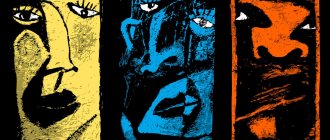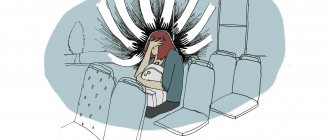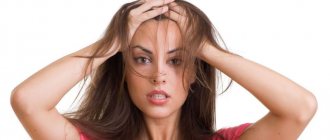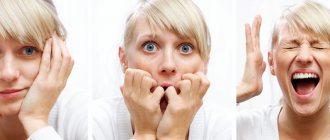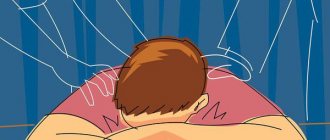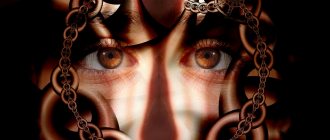- Affective respiratory syndrome
Mental disorders accompanied by a sharp change in a person’s emotional state are classified as affective disorders. They can be characterized by a sharp change in dynamics, disturbances in the manifestations of standard human emotions. Treatment of affective disorder in a specialized clinic in most situations can give a favorable prognosis for improving well-being and self-perception.
Affective disorder syndromes
Depending on the prevailing symptoms, various syndromes of affective disorders are distinguished:
- Depression associated with metabolic disorders of brain tissue. Manifestations of depression are associated with the patient experiencing a state of extreme despondency and hopelessness. This syndrome is characterized by suicidal thoughts, often leading to attempts to end one’s existence. Without the necessary therapy, the syndrome can last for a long period.
- Dysthymia differs from depression in its milder form. The patient becomes depressed during the day, anxiety increases, and mood worsens.
- In bipolar disorder, the patient experiences alternating phases of depressed mood and euphoria. Previously, this disease was called “manic-depressive psychosis.” In a depressed state, the patient's mood is depressed. Moving into the manic stage, the patient becomes cheerful, often excessively active, aggression, delusional ideas and irritability appear. In the case of the maximum stage of manifestation of changes in states, bipolar disorder is called cyclomia.
- In the case of depressive disorders, the patient suffers from increased anxiety, fear, and internal restlessness. The patient constantly expects the onset of tragedy, impending disaster. In severe cases, movement disorder and panic attacks are possible.
- Cotard's syndrome is accompanied by nihilistic-hypochondriacal delusions, accompanied by ideas of enormity. Occurs in involutional melancholia and recurrent depression.
- Manic syndrome (mania) is accompanied by a high level of joyful mood. The patient suffers from an increased desire for constant activity, there is an increased level of optimism, cheerfulness, and inadequate joy. Attention is distracted, superficiality of judgments is visible, verbosity, hypermnesia, thoughts are not completed, fatigue is absent, the attitude towards oneself is idealized. There is a mild manic state (hypomania).
Affective disorders require immediate consultation with a specialist. They often become the debut of various mental disorders. They are capable of persisting throughout the entire period of subsequent mental illness.
Causes
The etiology of a significant number of mental illnesses is under study. Bipolar affective disorder (BD) is no exception: the exact cause of the disease has not been determined. We can only talk about factors that influence the likelihood of its development:
- genetic predisposition - according to statistics, blood relatives with disorders in the neurotransmitter systems of the brain associated with the transmission of impulses between neurons are more often susceptible to the disease;
- acquired biochemical dysfunction of neurotransmitters, as well as other brain cells that affect the production of serotonin, dopamine, norepinephrine;
- prolonged exposure to stress, increased mental vulnerability.
Treatment of mood disorders
In medical practice, treatment for affective disorders is developed individually for each patient. It is necessary to take into account the present symptoms and the presence of additional diseases. When developing a program, procedures are carried out to:
- stop the active stage of the disease, if present;
- eliminate the cause of the pathology;
- carry out psychotherapeutic work;
- with the help of social work, increase adaptive abilities.
The composition of an integrated approach to the treatment of all types of syndromes includes:
- use of drug treatment;
- psychotherapy;
- social rehabilitation.
In case of acute exacerbation, suicidal thoughts, hospitalization is recommended. Each type of disease requires separate approaches when developing a course.
Affective mood disorder
Almost everyone has experienced mood swings, often without specific reasons. In some cases, such changes, caused by fatigue or based on pleasant occasions, cease to be only one of the manifestations of the norm. In this situation, they require diagnostics and development of a treatment program.
The cause may be genetic predisposition or external factors. For example, a strong shock caused by the death of a loved one. The reason is joy.
To correct the condition, a personal conversation between a specialist and a doctor is required to establish an accurate diagnosis. Elimination of provoking factors allows the state of affect to be relieved. Treatment uses sedatives and antidepressants.
Affective mental disorder
In such a situation, the patient’s condition becomes pathological and interferes with his normal life activities. Therapy is often lengthy. Requires the use of pharmacological drugs.
As in other situations with this disease, first of all the patient is removed from the acute attack stage. Identification of causes that can become a provoking factor is carried out in consultation with a psychologist. The pathology is characterized by alternating periods of exacerbations and remissions. Supervision by a specialist at any stage and attendance at preventive examinations are required.
Affective spectrum disorders
In most cases, doctors try to eliminate manifestations of affective spectrum disorders in restrictive conditions. Hospitalization is required for acute manifestations. At the initial stage of confronting the pathology, relief drugs are used with combinations of neuroleptics and antipsychotics. The use of anticonvulsants of the Valproate group may be required.
In the presence of psychosomatic symptoms, second-generation antipsychotics are used. Such as Serdolex, Clopixol Acufaz. The second generation of these drugs has fewer side effects. Drug resistance after 4 weeks of use becomes a recommendation for the use of anticonvulsants. Lithium salt is prescribed.
Depressive affective disorder
Directly translated in Latin, depression is called “dejection.” This condition cannot be completely cured today, but it can be corrected and stopped. Therapy helps improve the psychological and physiological state of the patient. Using a combination of psychological and biological treatment. In addition to medicinal drugs, folk recipes are distinguished by a high degree of effectiveness. First of all, herbal soothing teas, yoga. Patients are shown psychotraining courses and soothing baths. Following the rules of a healthy diet and avoiding alcohol plays a positive role.
Organic affective disorder
Antidepressants are used in treatment. They improve emotional well-being and reduce anxiety levels. It is necessary to remove the factors that provoked the condition.
An organic affective state is caused by physiological factors. Such as a long-term illness, withdrawal of certain medications, consequences of traumatic brain injury, postoperative condition.
The prescription of medications is carried out taking into account the medications that the patient is forced to take in accordance with the main diagnosis. In most situations, doctors prefer to focus on the use of psychotherapy, soothing infusions and teas, and physiotherapeutic procedures.
Manic affective disorder
The problem for conducting a successful course is often the patient's rejection of the diagnosis. A full examination is carried out to exclude concomitant dementia or schizophrenia. During therapy, sessions with a psychotherapist and prescription of medications are used. Anticonvulsant therapy is recommended.
In case of severe cases, compulsory hospitalization is required. In such a situation, doctors need the support of the patient's relatives.
Emotionally affective disorders
With such a lesion, a maximum change in the perception of the surrounding world occurs. The reaction to the provoking factor becomes excessive. There is a loss of understanding of the surrounding situation, and at the same time the understanding of a person’s actions in the current situation decreases.
The provocateur is prolonged exposure to traumatic events, leading to a pathological reaction of the brain. The patient loses control and does not adequately evaluate the actions taking place. Among the provocateurs are the death of a loved one, a sharp decline in social status and material level, and the occurrence of hormonal imbalance. The therapy uses tricyclic antidepressants, antipsychotics, mood stabilizers, tranquilizers, and mood stabilizers.
In the absence of positive dynamics, anticonvulsant therapy is prescribed. Psychotherapy sessions are conducted both with the patient himself and with his environment.
Bipolar disorder treatment
Courses of mood stabilizers are used for therapy. Such as Carbamazepine, lithium therapy, valproic acid. Treatment is divided into the stage of removing the patient from the acute stage and further preventive therapy, which can be carried out for life. At this stage, the use of a lithium solution is recommended. When you stop taking it, about half of patients relapse within a few weeks. Complete withdrawal within 5 years leads to relapse in 94% of patients.
This remedy shows a positive effect in 60% of patients with short cycles and up to 20% of patients with long cycles. Additional medications are prescribed. With the high potency of lithium, its positive effect occurs approximately 5 days after the start of treatment. During this period, other medications are used. Constant monitoring of the effect of the drug on the body is required. Treatment should be discontinued if dysarthria, widespread tremor and ataxia appear. Most often, negative symptoms are observed in the elderly and patients with poor health.
E. V. Bachilo
Definition.
Currently, this disorder is called bipolar affective disorder.
Thus, bipolar affective disorder (BD) is a chronic disease of the affective sphere. This disorder is characterized by the presence of manic, depressive, and mixed episodes. At the same time, during periods of remission, symptoms above the indicated phases are almost completely reduced. Thus, these periods are called intermissions, when no manifestations of the disease are noted. It should be noted that this disorder significantly impairs a person’s social and professional functioning, so patients need specialist help and treatment. Many experts note insufficient diagnosis of this disease. As a result, many patients do not receive the necessary effective therapy.
Prevalence.
The prevalence of bipolar disorder averages 1%. Also, according to some data: 1 patient per 5-10 thousand people. No significant differences were found based on any geographic or ethnic characteristics. This disorder begins relatively late. The average age of patients with bipolar disorder is 35-40 years. Women get sick more often than men (approximately in the ratio of 3:2). Note that bipolar forms of the disease are more common at a young age (up to about 25 years), and unipolar forms at an older age (30 years). As for the prevalence of the disorder in childhood, there is no exact data. The latter is determined by the limited application of existing diagnostic criteria in children.
Causes.
To date, the exact causes of the development of bipolar disorder have not been established. The most widely accepted is the genetic theory. The disease is believed to have a complex etiology (taking into account genetic, biological studies, studies of neuroendocrine structures, psychosocial theories). It was noted that there is an “accumulation” of cases of bipolar disorder and depression among first-degree relatives. The disease can occur for no apparent reason or after some provoking factor (for example, psychogenism or infectious diseases can serve as such factors).
However, there are a number of studies that show the presence of certain personality traits that are associated with an increased risk of developing bipolar disorder. Such features include:
- melancholic personality type;
- increased conscientiousness and various psychasthenic traits;
- anxious and suspicious personality traits;
- emotional lability;
Classification.
Today, there are several types of bipolar affective disorder.
Highlight:
- bipolar course - when the structure of the disease contains manic and depressive phases, between which there are so-called “light intervals”, intermissions;
- monopolar (unipolar) course - when either manic or depressive phases are found in the structure of the disease. The most common type of course is when only a pronounced depressive phase is present.
- continuum - when phases replace each other without periods of intermission.
There are also bipolar affective disorder type 1 and bipolar affective disorder type 2.
Bipolar affective disorder type 1 is characterized by the presence of manic and depressive episodes in the structure of the disease.
Bipolar affective disorder type 2 is characterized by the presence of severe depressive episodes, the absence of severe manic episodes, and hypomanic episodes may be present.
Symptoms.
Let's look at the main manifestations of bipolar affective disorder. As noted above, the disease is characterized by phases. The disease can manifest itself only in the manic phase, only in the depressive phase, or only in hypomanic manifestations. The number of phases, as well as their changes, are individual for each patient. The duration of the phases can vary: from several weeks to 1.5-2 years. Intermissions (“light intervals”) can also have varying durations up to several years (up to 3-7 years), but at the same time they can be quite short. It is important to note that the cessation of an attack leads to an almost complete restoration of mental well-being. During the course of the disease, even in the case of a long course and frequent occurrence and change of phases, the formation of a defect does not occur (as in schizophrenia), as well as any other pronounced personality changes.
Depressive episode.
The depressive phase is characterized by a number of features, which we will consider below.
— Endogenous depression (which is characteristic of bipolar affective disorder) is characterized by pronounced vitality, i.e. the biological nature of painful disorders involving not only mental, but also somatic, endocrine and general metabolic processes.
— The depressive triad includes: decreased mood, slowed thinking, slowed speech activity.
— Diurnal fluctuations in mood are characteristic. The mood is worse in the first half and improves somewhat in the evening. In the morning, patients wake up with a feeling of melancholy, anxiety, and indifference. By evening, the condition improves somewhat, and a little activity appears.
- Decreased appetite, perversion of taste sensitivity. Food seems to have “lost its taste,” patients lose weight, and women may lose their periods.
- Psychomotor retardation may occur.
- The presence of melancholy, which is often felt as a physical feeling of heaviness behind the sternum (precardiac melancholy).
- Libido is reduced or completely suppressed; maternal instinct.
— An “atypical variant” of depression may be observed: when appetite increases, hypersomnia occurs (the intervals of wakefulness become shorter and sleep more).
- Suicidal thoughts may occur. Patients with bipolar affective disorder have a suicide rate that is 20% higher than the general population.
— Quite often a somatic triad (Protopopov’s triad) occurs: tachycardia (rapid heartbeat), mydriasis (pupil dilation), constipation.
— A depressive episode can be accompanied by various psychotic symptoms and syndromes: delusions, hallucinations. Most often, delusional ideas in their content are: ideas of sinfulness, impoverishment, self-accusation. Hallucinatory experiences are manifested by auditory hallucinations in the form of “voices” that accuse or insult the patient. The indicated symptoms can be congruent with mood (i.e., determined by the emotional state, mostly determined by feelings of guilt, sin, damage, impending harm, etc.), and also incongruent with affect (symptoms have a neutral theme).
The following variants of the course of the depressive phase are distinguished: simple depression, which is characterized by the presence of a depressive triad, without psychotic symptoms (hallucinations, delusions); hypochondriacal depression, characterized by the presence of hypochondriacal delusions, which have an affective overtones; delusional depression (in the form of “Cotard’s syndrome”, which includes depressive symptoms, anxiety, delusional experiences of nihilistic fantastic content, has a wide, grandiose scope); agitated depression (accompanied by the presence of agitation); anesthetic depression (or otherwise this type is called “painful insensibility”, when the patient “loses” the ability to have any feelings).
It should be separately noted that in bipolar affective disorder (especially in the depressive phase), the level of suicidal activity in patients is quite high. Thus, according to some data, the frequency of parasuicides in bipolar disorder is up to 25-50%. Suicidal tendencies (as well as suicidal intentions and attempts) are an important factor determining the need for hospitalization of a patient in a hospital.
Manic episode.
Manic syndrome can range in severity from hypomania to severe mania with psychotic symptoms. With hypomania (increased mood), criticism of one’s condition is formal or absent, there is no pronounced social maladjustment. In some cases, hypomania can be productive for the patient. A manic episode is characterized by the following:
— The presence of a manic triad: increased mood, accelerated thinking, increased speech motor activity. Those. has opposite characteristics than depressive syndrome.
— During the manic phase, patients are active, feel a “strong surge of strength”, everything seems “on their shoulders”, they start many things at the same time, but do not complete them. Productivity is approaching zero. They often switch switches during a conversation, cannot focus on one thing, and can go so far as to constantly change: they either laugh loudly or start screaming.
— Thinking is accelerated, which is expressed in the emergence of a large number of thoughts (associations) per unit of time. Patients sometimes “can’t keep up” with their thoughts.
There are different types of mania. For example, the manic triad described above occurs in classic (cheerful) mania. Such patients are characterized by excessive cheerfulness, increased distractibility, superficial judgments, and unjustified optimism. Speech is inconsistent, sometimes to the point of complete incoherence. There are also variants of angry mania, when irritability, aggressiveness, pickiness, and dysphoric mood come to the fore.
Mixed episode.
This episode is characterized by the coexistence of manic (or hypomanic) and depressive symptoms. These symptoms last for at least 2 weeks or replace each other quite quickly (hours). It should be noted that the patient's disorders can be significantly expressed. The latter leads to professional and social disadaptation.
The following manifestations may occur:
- insomnia;
- suicidal thoughts;
- appetite disturbances;
- various psychotic features (mentioned above);
Mixed states have various manifestations: a sudden burst of joy during a melancholic state; deep melancholy (sadness) for several hours in a manic patient; various kinds of melancholic thoughts with speech and motor excitement; cheerful mood, which is revealed against the background of deep stupor.
Diagnostics.
The above symptoms are diagnostically significant for making a diagnosis.
However, there are a number of points to consider that should give you pause when considering a diagnosis of bipolar affective disorder. Such clinical signs include the following:
- the presence of any organic pathology of the central nervous system (tumors, previous injuries or brain surgery, etc.);
— presence of pathologies of the endocrine system;
- substance abuse;
— the development of symptoms is a “clear” response to any severe psychotraumatic situation;
— absence of clearly defined full-fledged intermissions/remissions throughout the course of the disease;
- lack of criticism of the transferred state during periods of remission.
Differential diagnosis.
Bipolar affective disorder must be differentiated from a variety of conditions. If the structure of the disease includes psychotic disorders, it is necessary to separate bipolar disorder from schizophrenia and schizoaffective disorders. Type 2 bipolar disorder must be distinguished from recurrent depression. It is also necessary to differentiate between bipolar disorder and anxiety, personality disorders, and addictions. If the disease developed in adolescence, it is necessary to separate the disorder in question from hyperkinetic disorders. If the disease develops at a late age - with dementia, affective disorders that are associated with organic diseases of the brain.
Treatment of bipolar affective disorder.
Treatment for bipolar affective disorder should be carried out by a qualified psychiatrist. Psychologists (clinical psychologists) in this case will not be able to help you recover.
According to clinical recommendations adopted by the Russian Society of Psychiatrists, treatment of bipolar disorder is divided into 3 main stages: relief therapy, maintenance and anti-relapse.
The main goal of relief therapy is to relieve existing symptoms and minimize side effects. Maintenance therapy is necessary to maintain the obtained effect. Anti-relapse therapy aims to prevent relapses (the occurrence of affective phases).
For the treatment of bipolar affective disorder, drugs from different groups are used: lithium drugs, antiepileptic drugs (valproate, carbamazepine, lamotrigine), antipsychotics (quetiapine, olanzapine), antidepressants, tranquilizers.
It should be noted that therapy for bipolar disorder is carried out for a long time, from 6 months. and more.
In any case, consultation with a specialist (psychiatrist) is necessary to select adequate therapy.
Psychosocial support and psychotherapeutic measures can significantly help in the treatment of bipolar disorder. However, we note that they cannot replace drug therapy. Today, there are techniques specially developed for the treatment of bipolar affective disorder that can reduce interpersonal conflicts, as well as somewhat “smooth out” circadian rhythms (cyclical changes in various environmental factors, such as daylight hours, etc.).
Various psychoeducational programs are conducted to increase the patient’s level of awareness about the disease, its nature, course, treatment, prognosis, as well as modern methods of therapy. This helps to establish better relationships between the doctor and the patient, adherence to the therapy regimen, etc. Some institutions conduct various psychoeducational seminars at which the issues outlined above are discussed in detail. There are studies and observations showing the effectiveness of using cognitive behavioral psychotherapy in conjunction with drug therapy. Individual, group, and family forms are used. The use of psychotherapy can help reduce the risk of relapse.
Today there are self-registration cards for mood swings, as well as self-monitoring sheets. These forms help to quickly monitor changes in mood and promptly adjust therapy and consult a doctor.
Separately, it should be said about the development of bipolar disorder during pregnancy. Note that bipolar affective disorder is not an absolute contraindication for pregnancy and childbirth. The most dangerous period is the postpartum period, during which various symptoms can develop. The issue of using drug therapy during pregnancy is decided on a case-by-case basis. It is necessary to assess the risk-benefit of using medications and carefully weigh the pros and cons. Psychotherapeutic support for pregnant women can also help. If possible, you should avoid taking medications during the first trimester of pregnancy.
Forecast.
The prognosis in the presence of the disease depends on the type of course of bipolar affective disorder, on the frequency of phase changes, the severity of psychotic symptoms, as well as the patient’s adherence to therapy and control of his condition. Thus, in the case of well-chosen therapy and the use of additional psychosocial methods, it is possible to achieve long-term intermissions, patients are well adapted socially and professionally.
Bipolar affective disorder symptoms
This disease leads to a person’s complete loss of orientation in the world around him. Suicidal thoughts arise, careers end, and interpersonal relationships are destroyed. The disorder provokes life-threatening antisocial behavior.
The main symptom is a sudden change in mood. Depression gives way to euphoria. The change of cycles is chaotic. The duration of the phases cannot be determined. Sometimes the phases last for years. In the interval between attacks, there are no outward manifestations of the diagnosis and the patient feels completely healthy.
During depression, irritability, unmotivated anger, hopelessness and embarrassment are noted. In the euphoric stage, the patient may be prone to excessive spending or uncontrolled sexual relations.
The physiological state changes during different phases. During the manic stage, the patient feels a surge of strength, he is overly active, mobile, laughs often, speech becomes loud, and movements are impulsive.
The depressive stage is characterized by a sharp loss of strength. It becomes difficult for a person not only to move, but also to think. The duration of the depressive state is about two weeks. A repetition of the change of state occurs in most cases at least once every two years with the most ideal course of the disease.
The onset of the disease often occurs at the age of 20-30 years. Relatives may mistake the condition for a mental disorder. On average, the disease affects two out of a hundred people.
Stages of the depression phase:
• initial – weakening of tone, performance and mood drops, it is difficult to fall asleep and sleep is superficial. However, in the evening the condition improves;
• increasing – the mood noticeably worsens, speech becomes slow and quiet, appetite decreases, movements are inhibited. Anxiety, insomnia occurs, physical and mental performance is greatly reduced;
• pronounced – maximum stage. The patient painfully experiences melancholy, whispers, answers questions in monosyllables and after a long silence. Characterized by delusional ideas, anorexia, lying or sitting in one position, suicidal thoughts, hallucinations;
• reactive – reduction of the mentioned symptoms occurs, but asthenia persists for some time.
The duration of the phases can vary from one and a half to two years, and intermissions, that is, “light” intervals, from three to seven years. Their number is unpredictable, as is the alternation.
If symptoms worsen, you cannot do without professional help, since in the depressive phase the patient falls into despair and may commit suicide, and in the manic phase, he can spend all his money, commit an inappropriate act, and harm his health by taking alcohol and drugs.
Bipolar affective disorder diagnosis
The diagnosis is carried out by a psychiatrist or psychotherapist. When determining the diagnosis, the following is carried out:
- conversation with the patient and his environment;
- conducting a pathopsychological study by a clinical psychologist;
- laboratory tests are performed, including a blood test, neurotest, EEG, and a neurophysiological test system is prescribed;
- Consultations with a neurologist, cardiologist, and endocrinologist are necessary.
In difficult cases, it is recommended to undergo a medical commission that brings together several specialists. At the moment, signs of the disease cannot be detected using CT and MRI.
Symptoms of mood disorders
Accurate diagnosis of affective disorders is complicated by a wide range of causes that can provoke deterioration in health. The disease cannot be self-diagnosed. Only a psychiatrist or psychotherapist can give an accurate assessment. Specialists determine the exact diagnosis.
However, in medical practice there is a list of symptoms that suggest the presence of an affective disorder. Signs common to all types:
- mood changes occur with high frequency for a long period;
- the level of activity and mental pace decreases;
- a person’s perception of himself and situations changes dramatically;
- a noticeable decrease in the level of activity, depression, loss of interest in what is happening;
- appetite changes, usually decreases to complete starvation, but can also increase sharply;
- the patient is tormented by lack of sleep;
- moral suffering can lead to pain in any part of the body without any reason;
- sexual activity decreases, to complete asexuality.
Correct treatment can only be prescribed by a specialist after consultation.
Types of Mood Disorders
All types of affective disorders are described in the international classifier under the ICD 10 code, episodes F30-39. According to the classifier, types are defined as follows:
- F30 manic episode, diagnosed only in the case of a one-time manifestation of the disease; if repeated, doctors establish the fact of bipolar disorder;
- F31 bipolar mental disorder, characterized by recurrent occurrences;
- F32 depressive episode, accompanied by a decrease in activity, the presence of a depressed mood, increased fatigue, decreased appetite, insomnia, decreased self-confidence and self-esteem. It can be mild, pronounced and severe.
- F33 recurrent depressive disorder is defined by the presence of recurrent episodes of depression. There are no mood swings, with the change from mania to euphoria. The onset of the disease is possible at any age. Including in childhood. With a manic episode, especially if it recurs, it is classified as bipolar disorder.
- F34 persistent mood disorders that last for years, often throughout life, but are not severe enough to be classified as a mild depressive episode or a hippomanic episode.
- F38 Other mood disorders that do not fall into the types listed.
- F39 NOS (affective psychosis).
The diagnosis is made in a clinical setting. Accurate diagnosis is carried out only by a qualified psychotherapist or psychologist.
Anxiety disorder
With an anxiety disorder, the patient is dominated by tension, fear, and worry. He constantly expects a negative event (the presence of a dangerous illness in himself or a loved one, the death of a relative, etc.), the probability of which is low. All his thoughts and conversations are occupied by contrived “grief,” his appetite decreases, and insomnia begins.
In severe cases of anxiety, agitation may occur with constant pacing around the room and an inability to sit still. Panic attacks are simultaneously manifested by autonomic disorders - increased sweating, fluctuations in blood pressure, shortness of breath, nausea and dizziness.
Diagnosis of affective disorders
In the case of sudden mood swings, the presence of affective disorders can be assumed. Common to all types of these diagnoses is a possible connection with seasonality. Exacerbations are often associated with climatic changes in natural conditions. Activation of the diagnosis is directly related to stressful situations in most patients.
The patient or his relatives can only assume the possible presence of such a diagnosis. For an accurate determination, a visit to the doctor is required. Installation is carried out after a personal consultation with a psychologist or psychotherapist. Mood disorders cannot be completely cured. In order to exclude relapses, observation by a doctor will be lifelong.
To establish a diagnosis, laboratory tests are performed: EEG, blood test. First of all, they are designed to exclude the presence of additional diagnoses. MRI or CT scans are not used for research.
Affective personality disorder
Mood dysregulation affects many people throughout their lives. Impressionable citizens who are prone to heightened perception of what is happening suffer from such changes or are simply different. But not all cases of dysregulation are clinical.
The pathology is characterized by a noticeable and cyclical change of depression and euphoria. In the absence of treatment, such changes can occur even without additional provoking factors.
Patients suffering from affective personality disorder of any type are rarely able to control the change in their condition. To monitor the condition, observation by a specialist is required in order to promptly initiate drug treatment. Affective personality disorder without treatment leads to the destruction of the patient’s personality. It reduces the quality of life and destroys personal and social life. Periods of low and high energy destroy the body, often leading to suicidal tendencies.
Seasonal affective disorder
It is observed in people prone to seasonal depression. The periods occur at approximately the same time of year. Within the general disorder it is classified as F32.1.
There are two types. The most common is winter, starting in the autumn months. Typically in September and October. The active period lasts until early spring. Much less common is the summer type, which lasts from early spring to late autumn.
The first attack in most cases occurs between 15 and 55 years. The average age of patients first presenting with seasonal affective disorder is 23 years. The risk of developing the disease decreases with age. Depending on the season, women suffer from depression more often than men.
About a third of patients tolerate seasonal depression quite easily. The disease manifests itself in the form of some loss of strength and deterioration in mood. Most patients experience seasonal depression with difficulty. They worsen the quality of life, destroy personal relationships, and ruin careers.
At risk are:
- people with a family history of mood disorders and GAP;
- residents of northern latitudes, where daylight hours are very short most of the day.
Patients suffer from decreased libido, increased drowsiness, hypochondria, and continued fatigue despite long periods of rest. Autonomic disorders are observed.
This type of affective disorder in most situations goes away completely on its own after the season ends.
As a result, it is worth noting that with proper treatment, affective disorders are successfully corrected, moving into a state of stable remission. To avoid relapses, patients require constant medical supervision, compliance with recommendations and, if necessary, taking medications.
Affective syndrome is a fairly common cause of disruption of the human body. It is characterized by the onset of changes in the functioning of the brain at the dienfective level. Due to this, the regulation of the biotones of the body is disrupted; due to a decrease in their regulation, mood and the pace of mental processes occur. Treatment of affective syndrome is carried out under the supervision of specialists.
Affective outbursts in adults
The cause of affective outbursts in adults can be a variety of situations that draw consciousness into an emotional ring. Attention is concentrated on irritating circumstances, causing intense reactions in the nervous system.
The most common causes of affective outbursts include:
- sexual dissatisfaction/dysfunction;
- jealousy;
- insult and humiliation of a person;
- chronic fatigue/lack of sleep;
- threat to health/life.
What to do?
Aggressive behavior helps the body get rid of accumulated tension. Not everyone can get out of this state on their own, so emergency help from a psychologist (in mild cases) or a psychiatrist (in more complex cases) is recommended. An experienced doctor will select therapy or prescribe medications.
The following techniques will help you survive an affective outburst:
- switching attention and physical influence to a safe object - beating a pillow, a pear, screaming at the top of your voice.
- wash with cold water.
- if a person is in an uncontrollable state of hysteria, a slap in the face or a shake will help him switch and return “to himself.”
The consequences of affective behavior can be of varying degrees of severity - from feeling tired and deteriorating in general well-being to committing a crime. Leaving this condition unattended is unacceptable and dangerous. Playing sports, confidential conversations with loved ones, harmonious relationships in the family will help you cope with emotional disorders and once again feel such valuable peace and tranquility.
Manifestation of affective syndrome
Pathology manifests itself in the form of negative emotional disorders, depressive states and mania. In some cases, accompanied by physiological disorders:
- difficulty breathing with a feeling of incomplete inspiration;
- heaviness in the chest;
- inhibition of movements and reactions;
- slowing down thought processes;
- loss of interest in things that were previously important to the patient.
Various types of depressive states manifested in pathology:
- manic-depressive psychoses;
- psychogenic depression;
- endogenous depressive states;
- depression of a somatic nature.
It is characterized by a sharp change, often occurring within one day. The period of attacks can last for several months and even years. Sleep disturbances are observed, appetite changes, and weight loss may occur.
Mania and bipolar disorder
In manic disorder:
- unnaturally elevated mood;
- fast pace of thinking;
- inability to focus on one thing or thought for a long time;
- hyperactivity;
- state of joyful excitement;
- inadequate optimism, inability to take anything seriously;
- active gestures, constant movement from one place to another.
To a person with this pathology, all problems seem trivial, and the feeling of fear and danger decreases. The patient considers himself capable of “moving mountains”, his need for sleep is shortened to 3-4 hours a day, and he does not feel tired. According to the degree of severity, doctors distinguish between classic mania and hypomania, in which the symptoms are somewhat erased.
If a patient has a cyclical pattern of mania and depression, then he or she requires treatment for bipolar disorder.
In clinical practice, there are several subtypes of this disorder:
- First (I). It is diagnosed if there is at least one case of manifestations of mania, which is then replaced by depression, or proceeds without it.
- Second (II). It manifests itself as a mandatory alternation between hypomania and a depressive state.
- Cyclothymia. The least severe form of manic-depressive psychosis with periods of hypomania and dysthymia.
According to the type of flow and sequence of alternation of affects, there is:
- double manic-depressive psychosis, when mania follows depression, and then there is a “light” interval;
- ordered - there are gaps between each episode;
- circular - a constant series of manic and depressive states, with no “bright” intervals.
Mania or depression can last from one week to several years. And the time when a person does not show signs of the disease is from 3 to 7 years.
Treatment of affective syndrome
When eliminating pathology, complex therapy is used with the use of medications and psychological training. Patients with mental disorders manifested in panic attacks are prescribed classes to master self-regulation techniques. Work is being done to improve self-esteem.
Social adaptation is used for successful therapy. In such a situation, the participation of family members and the patient’s immediate environment is recommended in group psychological trainings.
Questions and answers
How long should depression be treated?
It all depends on the type and severity of the depressive state; in each specific case, the duration of medication and rehabilitation therapy may vary. The first effect after starting treatment becomes noticeable in about 1-2 weeks. For more detailed information, it is best to consult your doctor.
Do people with bipolar disorder need to be hospitalized?
In mild cases of the disease, a person’s condition can be improved on an outpatient basis. But severe mania or severe depression requires adjustment of medications taken and round-the-clock monitoring, and this is only possible during the patient’s hospital stay.
Affective syndrome in children
Affective disorders of depressive and manic types occur not only in adult patients, but also in children. Medicine is not able to accurately determine the cause of these disorders in minors. Provoking factors include genetic predisposition and constant traumatic situations. Manifestations are observed at the earliest stages of child development. The period from 12 to 20 months is especially dangerous for the start of the diagnosis.
The unstable psycho-emotional state of the baby with frequent mood swings allows one to suspect the presence of a diagnosis. Children suffer from hallucinations. Attacks may occur over significant time intervals. Immediate medical attention is required:
- in case of threats to commit suicide;
- attempts to cause physical harm to oneself;
- identifying cases of hallucinations.
Treatment is carried out jointly by a child psychologist, a psychiatrist, and a pediatrician. Due to the lack of a clear understanding of the causes of the onset of the disease, there are no preventive measures. If the disease is detected early, the prognosis is favorable. The combination of drug therapy and psychological practices makes it possible to reverse the development of pathology in a child.
A type of affective syndrome
Diagnosis and successful initiation of treatment for affective syndrome is associated with a clear definition of the type of pathology.
Affective respiratory syndrome
The cause of the onset of pathology is a serious psycho-emotional stimulus. Accompanied by attacks of suffocation, panic attacks caused by the inability to continue normal breathing. It occurs quite rarely in adult patients, due to the acquisition of the skill to control one’s emotional state in the event of sudden moral and physical shocks.
Affectively delusional syndrome
A polymorphic psychotic disorder, often caused by schizophrenia. Manifestations in situations of diagnosing delirium and depression in patients suffering from various mental illnesses.
Affectively paranoid syndrome
Refers to exacerbations in recurrent and schizophrenia, acute paraphrenia and other psychiatric diagnoses. It manifests itself as symptoms of switching off consciousness in the form of coma, a state of stupor, hypochondria, and a constant feeling of guilt. Accompanied by movement disorders. Such as agitation, the speed of associations changes from complete slowdown to acceleration at the level of a “whirlwind of ideas.”
Affectively endogenous syndrome
Occurs with endogenous diagnoses, somatogenic mental pathologies. Accompanied by frequent changes in mood phases. The maximum duration of depressive periods lasts up to 6 months. During the period of remission, the pathology may be virtually invisible.
Affective respiratory syndrome in children
It is a frequent response of the body to sudden provoking situations in the form of holding or even stopping breathing. This manifestation also occurs in a situation of prolonged prolonged crying. May be accompanied by convulsions and loss of consciousness. In rare situations, it turns into epilepsy.
Affective instability syndrome
A state of emotional instability that is on the verge of normal. It is recommended to contact a specialist:
- in case of frequent breakdowns, the so-called “crazy”;
- affective outbursts;
- mood swings, often occurring at an unconscious level;
- low level behavior control.
Manifestations in most situations are associated with stressful conditions and weather changes. Unstable psychopathy borders on schizophrenia.
Affective depressive syndrome
Constantly depressed mood, energy and performance decrease, often patients are characterized by a refusal to control their appearance. Ungrooming appears. The mood does not improve in pleasant company. Thoughts about suicide often appear.
Affective pathology syndromes
Extremely diverse. A common symptom is a disturbance in the emotional state from a state of excessive joy to deep depression. If frequent mood swings are detected, it is recommended to consult a specialist for an accurate diagnosis.
Affectively hallucinatory syndrome
It is characterized by a combination of delusional and hallucinogenic disorders. Patients may experience visual and auditory hallucinations, decreased emotional status, or, conversely, increased agitation.
What it is?
An affective outburst is a discharge of stagnant affect. It is characterized by a short-term emotional outburst with violent motor activity and disturbances in the functioning of internal organs.
Affects are not categorized as feelings, emotions and moods. Affects reflect the subjective perception of the situation, accompanied by pronounced changes in behavior and functioning of the central nervous system. That is, an affective outburst always (!) occurs as a reaction to some situation that causes an intense response from the nervous system.
They are:
- Physiological nature;
- Pathological in nature.
Affective outbursts of a physiological nature do not entail a loss of self-control, but refer to the normal expression of emotions, which is not painful. Pathological outbreaks are characterized by complete or partial loss of consciousness, followed by amnesia.
